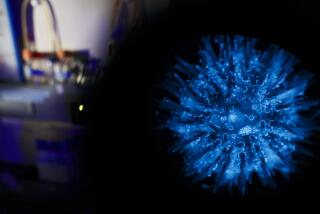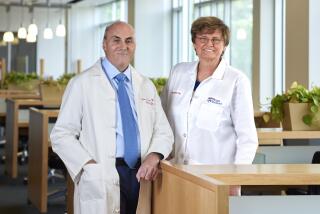Q&A: Why CRISPR-Cas9 is being hailed as the scientific ‘Breakthrough of the Year’
CRISPR is having a moment.
This week the gene editing system was declared the “Breakthrough of the Year” by editors of the journal Science. A day earlier, Nature named the Chinese researcher Junjiu Huang one of the 10 people who mattered in 2015 for being the first to use the CRISPR system to edit the DNA of human embryos (albeit ones that weren’t viable).
Last month, researchers from UC Irvine and UC San Diego showed how mosquitoes genetically modified using the CRISPR system can be programmed to fight malaria in their bodies and pass that trait to 97% of their offspring. And just a few weeks ago, hundreds of geneticists, biologists, ethicists and scientific policymakers convened in Washington for a three-day conference to address the ethics of using this powerful — and controversial — technology.
Scientists say that what sets CRISPR apart from other gene-editing technologies is how easy it is to use. But just because it’s easy to use doesn’t mean it’s easy to understand. Here, we walk you through everything you need to know about CRISPR-Cas9, including what it is, how it works, and what we can expect from it in the future.
What exactly is CRISPR-Cas9 and why should I care about it?
CRISPR-Cas9 is a new technology for editing genes in living organisms. Scientists who use this technology say it has made targeting and changing genes in a cell’s DNA easier and more precise than ever before.
Now that changing specific genes has become more straightforward and significantly less expensive, more scientists are more likely to fiddle with the instructions that control how living things are made.
Haven’t scientists been editing genes for a while?
Yes, researchers have been editing genes in some organisms since the 1970s.
So what makes CRISPR so special?
It’s much easier to employ than older gene editing technologies, and it also has a very high success rate.
Because it is more user-friendly to the average scientist, it has opened the door to all kinds of research that previously would have been too expensive or required too much time to carry out.
See more of our top stories on Facebook >>
Why is it called CRISPR?
CRISPR is an acronym for Clustered Regularly Interspaced Short Palindromic Repeats. Since that’s a mouthful, you can just say “crisper.”
I don’t have a degree in genetics. Can someone like me understand how it works?
Yes, you can -- we’re going to take this step by step:
The most basic form of the CRISPR system is made up of two parts: a small piece of RNA and a protein called Cas9.
Before injecting the CRIPSR system into a cell, scientists program the RNA to match the code of a specific gene in the target cell’s DNA that they want to alter.
Once the RNA and the Cas9 are inside the cell, the two molecules sort of stick together. The RNA guides the Cas9 to a particular part of a gene, and the Cas9 acts like a pair of scissors, breaking both strands of DNA at that specific spot.
Cells don’t like having their DNA cut, so they try to make repairs right away. Some CRISPR systems include an additional piece of DNA that the cell can use to fix the break, thereby allowing scientists to rewrite genetic code.
Perhaps a metaphor would help. Paul Knoepfler, a stem cell researcher at UC Davis, describes CRISPR as a molecular Swiss army knife: It’s part genome scanner (like a magnifying glass tool on the knife), part scissors to cut the DNA, and part pencil to re-write the genetic code.
How new is the CRISPR system?
It depends on how you look at it. Bacteria and other single-celled organisms have been using the combination of guide RNA and a scissors-like protein to chop up the DNA of unfriendly viruses for hundreds of million of years. However, scientists only learned of the system in the 1980s, and it wasn’t until 2012 that they first understood how all the components worked together, making it possible for other researchers to use.
The first applications of CRISPR technology in living cells came along in early 2013. Since then there has been an explosion of labs using the system for a wide variety of research.
What can we expect from this technology in the future?
The CRISPR system is not foolproof. It doesn’t work all the time, and it occasionally causes changes in genes that weren’t intended.
However, as the technology continues to get better CRISPR could be used to correct the faulty DNA that’s responsible for genetic diseases like cystic fibrosis, sickle cell anemia, hemophilia and perhaps muscular dystrophy. As long as scientists can identify which mutation causes these diseases, they could, in theory, use CRISPR to find these genes, break them, and replace them with healthy versions.
Other researchers are experimenting with using CRISPR to take genes that work fine and make them even better. For instance, they’d like to make small alterations to genes in crops and livestock to create plants that need less water, or cows that build more muscle mass without requiring extra feed.
That all sounds great. Why is this controversial?
Part of what makes CRISPR controversial is that it’s so easy to use. That also makes it easy to abuse.
Some scientists, including Jennifer Doudna of UC Berkeley, who co-invented the gene-editing technology, are particularly concerned that people might try to make genetic modifications to viable human embryos.
Why would that be a problem?
Dana Carroll, a biochemist at the University of Utah, says there are several issues with using CRISPR — or any other gene-editing technology — to alter human embryos. For example, an attempt to correct one gene could lead to an unexpected alteration in another.
Also, depending on when that change is made, it could be transmitted to that child’s offspring. So if a mistake is made, multiple generations could be stuck with the consequences. It is also possible that parents who make edits to their child’s genome may be making decisions that the child herself would not have chosen. Some bioethicists consider this unfair.
How are scientists addressing this controversy?
Scientists from around the world recently gathered for the International Summit for Gene Editing in Washington, D.C., to discuss technologies like CRISPR and the ethics of using them.
At the end of the summit, they released a statement that acknowledged the importance of using these technologies in the lab and the scientific value of studying how they work in embryos, including human embryos. However, they also said it would be “irresponsible to proceed with any clinical use” of gene editing that would be passed along to future generations.
------------
FOR THE RECORD
Dec. 20, 4:32 p.m.: A previous version of this story said scientists at the International Summit for Gene Editing called for a moratorium on making DNA changes that could be passed along to future generations. The attendees stopped short of calling for a ban or moratorium.
------------
Carroll said they came to that conclusion because the technology isn’t ready yet and because society isn’t ready for it either.
“It’s scary for people to think that their genes, or their children’s genes, could be changed by human intervention,” he said.
The scientists also agreed to keep talking, because this issue is not going to disappear anytime soon.
Do you love science? I do! Follow me @DeborahNetburn and “like” Los Angeles Times Science & Health on Facebook.
MORE IN SCIENCE:
FDA proposes ban on indoor tanning for minors
What zombies can teach us about infectious diseases
Fluid dynamics on four legs: The brilliance of how dogs drink







